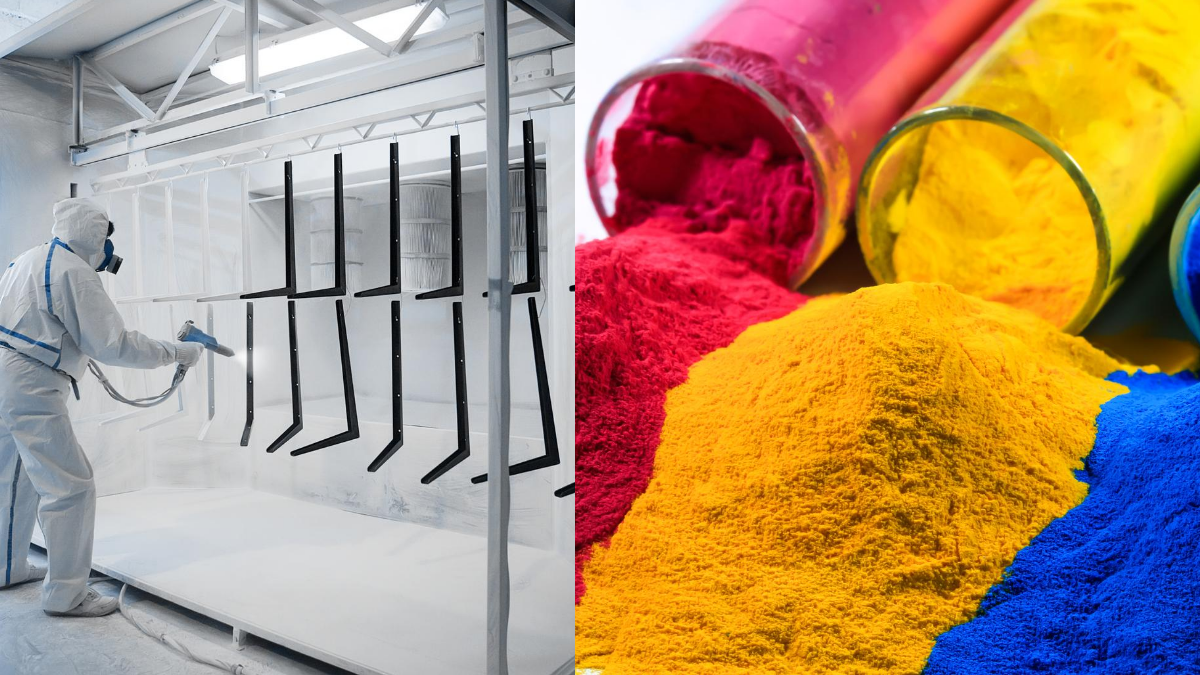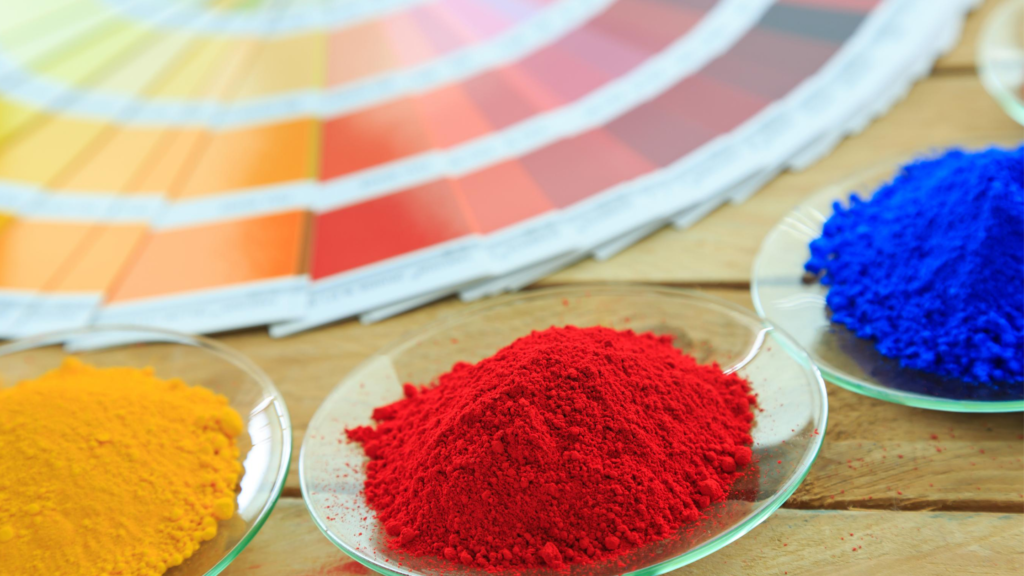The powder coating process is a method of spraying electrostatically charged dry powder over the material surface. The powder coating process is also known as the electrostatic spray deposition process. The dry powder constitutes a combination of finely ground pigments and resins. Powder coating was introduced in the late 1980 s and is being extensively used in the industrial, commercial, and household applications. This process provides a smooth, durable, decorative, and a corrosion-resistant coating.

Difference between Powder coating process and Polyester Powder coating
A lot of confusion is prevailing between the terms, “Powder Coating” and “Polyester powder” coating. Powder coating is the method of application of electrostatically charged dry powder to the material to be coated. Powder coating can be applied on any surface. However, the powder coating ingredients differs with material types and the environment where it is used. The most popular powder coating types are Epoxy Powder Coating, Polyester Powder Coating, and Hybrid Powder Coatings.
Polyester powder coatings preferred in applications are classified into TGIC Polyester coating and Urethane polyester coating. For aluminium extrusions, TGIC Polyester coating is preferred due to there low temperature curing properties.
Also read : Aluminium Anodising Process -A remarkable Finish Coating
Powder coating process
Powder coating process is broadly classified into three important stages.
- Surface preparation
- Powder coating process
- Curing process
Surface Preparation
The durability and serviceability of a coating depend on the quality of surface preparation. Surface preparation is essential to remove the dirt, grease, and other impurities from the material surface. The cleaning process includes various stages of cleaning, rinsing, etching, blasting, and drying, etc. The surface preparation stages are as follows.
- Chemical cleaning
- Conversion coating
Chemical cleaning
The chemical cleaning process uses mild alkalies(caustic soda), acids, and detergents for cleaning. The cleaning process is followed by rinsing with hot water, steam, detergent, etc. However, the type of acid/alkali cleaners depends on the material type to be coated. For example, aluminium is sensitive to acid attacks and requires mild alkaline cleaners. Rinsing with nitric acid done on anodised surfaces.
On completion of the cleaning process, the surface feels smooth and free from grease, oil, impurities, etc

b) Conversion coating
A conversion coating is applied on the surface to enable strong adhesion with powder coating. The chemical solutions for conversion coating are selected based on the type of material to be coated. For aluminium surfaces, the conversion coating is applied for a surface with strong adhesive nature and to arrest the progress of oxidation before powder coating.
For aluminium surfaces, conversion coating uses chromatic or phosphate solutions. In mild steel Zinc phosphate/ iron phosphate solutions are used. After completing the conversion coating, the coated material is cleaned in rinsing tanks. The final rinse is done using simonized water. The rinsing process removes chemical salts and other residues from the surface of the material that can trigger corrosion and can affect the coating adhesion properties
On completion of the conversion coating, the material is dried in a drying oven to remove any possible moisture before application of the coating.
Powder coating process-Types
Once the drying process is over, the clean and dry material from the drying oven is shifted to a powder coating booth for powder coating. The powder coating application is commonly done in two methods based on the type of material and environment where it is used.
- Electrostatic deposition
- Fludized bed powder coating
Electrostatic deposition
In Electrostatic spray deposition or ESD method of powder coating, the finely ground powder is sprayed by a gun to the material. The entire system constitutes a spray booth, a powder feeder, an electrostatic spray gun, and a power unit.
For the ESD process of powder coating, a finely ground resin and pigment powder are charged inside a gun. The material to be coated is grounded/earthed to provide an opposite charge. The electrically charged particles from the gun are sprayed on to the earthed material. The powder on leaving the gun gets attracted to the earthed parts due to electrostatic attraction. In this process, areas that are not even in line with the gun also get attracted to the material to be coated. The powder will continue to stick on the surface as long as it is grounded/earthed. The thickness of the coatings depends on the type of environment the part will be used in. Any powder left after the coating is reclaimed and reused.

Fluidized bed powder coating process
In the Electrostatic deposition process, the powder coating material is electrostatically sprayed and adhered to the surface. But in the case of fluidized bed powder coating, preheated parts are dipped to the powder material within a fluidized bed. There is also an alternative option called electrostatic fluidized bed powder coating, which generates a cloud of electrically charged powder particles above the fluidized bed through which the part to be coated is passed.
Curing of coated materials
The coated materials are co to an oven, where the painting process gets completed by ‘curing’ the particles.
The oven heats the metal to about 200°C. The high temperature first fuses and melts the powder particles, allowing them to flow together to form a film and then cures the resin system in the film to form a smooth surface.
Other additives within the powder formulation make them anchored to the conversion coating, developing a cohesive structure.
After the curing oven, sections are transported to a cooling station, inspected, packed, and dispatched.
Advantages of powder coatings process over liquid coatings
The wet painting system was the most common and traditional coating method. In this method, water-based or solvent-based paint is sprayed or painted to the material surface. Many concerns or issues associated with liquid paints are eliminated or minimised with the powder coating process. The advantages of powder coating over wet paint are listed below.
Resistance to corrosion and chemicals
Powder coatings are more durable and more resistant to corrosion, chemicals, weather, etc than liquid coatings. Powder coating provides wear, scratch-free, and abrasion-resistant coatings in comparison with liquid paints. The application process of powder coating is thermal bonding which provides a uniform, smooth, and even coating. The colours always look fresh and bright and give a refreshing look than liquid paints.
Color choice
Powder coatings offer an unlimited range of colours, finishes, textures, which is not achievable through any type of conventional liquid coating method. Powder coating can match the colour scheme of any object/structure. The enormous choice of colours and textures ranging from matt, glossy, and textured to metallic finishes makes powder coating one of the most preferred coating choices. Powder coating can be used as a protective coating as well as decorative applications.
Durability of powder coating
Powder coatings are long-lasting and durable than any other liquid coatings. Powder coatings offer high resistance to impact, moisture, chemicals, wear, and abrasion compared to any other liquid coatings. They can also protect the materials against possible scratches occurring during the fabrication and fixing of the material and can be used in high traffic areas.
Environmental friendly
The liquid coatings emit VOC s (volatile organic compounds) due to the presence of solvents and cause serious environmental issues. Powder coating is free of any solvents and does not emit any VOCs and is thereby considered a green product. Moreover, the powder coating process does not create any hazardous waste that needs disposal. Any waste powder left after the coating is reclaimed and used. Powder coating is considered an environmentally friendly alternative to liquid coatings and thereby extensively used for green building-related projects.
Operational cost of powder coating
Powder coating is an economic option when compared with other organic finishes/ liquid painting methods. The powder coating application can be done with minimal training and supervision and thereby can reduce costs related to labour and operations. Powders left after the coating is recycled and reused. Fewer energy costs, reduced disposal costs, and low reject costs makes powder coating an economical option. Powder coating also has a longer life span when compared to other coatings and this can be another value addition in terms of money.
Safety
Liquid paints are flammable, carcinogenic, and full of volatile organic compounds and are harmful to the environment as well as the workers involved in the process, if not handled properly. Powder coating consists of solids and no solvents and hence is not harmful to persons handling it. Moreover, powder coatings possess good fire rating qualities in comparison with other liquid coatings.
Disadvantages of powder coating process
Thin coatings are difficult to produce
Powder coatings are 100% solid and because of this, even with a minimum amount of application, the initial thickness is formed. Moreover, it does not contain any volatile organic compounds. This makes it impossible to have thicknesses of less than 25 microns. Whereas in liquid paint, we have paint thinner and it is possible to have a lower percentage of solids, the film thickness can even be limited to 10 microns..
Failure of coating on exposed to atmosphere
On exposure to extreme atmospheric conditions like sunlight, heat, humidity, etc powder coating tends to fail, crack, and peel off. Hence not preferred for external applications involving exposure to extreme atmospheric conditions.
Color change after application
The production process and blending of powder coatings are carried out in a molten form. Hence it is not possible to change the color after production. Whereas in liquid paint we can change the color in all the stages, even when applying the paint, by adding stainers and pigments.
Size of coating material
The spray equipment and method of application of powder coatings confine the coating application to spray chambers only. Substrates must be charged and on completion of the coating. The materials have to be transferred to an oven where the curing process involving a temperature up to 200 degrees is done. Considering these conditions, it is not possible to coat and cure large substrates.
Oven curing
Powder coatings only dry and cure in temperatures above 180 degrees. Whereas liquid paints are varied and could dry up even in room temperature.
Control of material quantity and smoothness
Powder coating offers less control over the speed and amount of powder coating applied. The smoothness of the coating cannot be controlled as it is happening inside the oven.
Start up costs
The start up costs are high for powder coatings. Requires skilled workers for coating and operation of the plant.
After considering the limitations and advantages of powder coatings, and the selected product to be coated, you can evaluate whether coating metals with liquid paint or powder is more suitable.
Uses of powder coating process
Powder coating process is being used for a wide range of applications ranging from household , commercial, industrial ,automobile sectors.
Appliances
Powder coating is used for appliances like stoves, refrigerators, washers, dryers, dishwashers, air conditioners, water heaters, microwave ovens, and many other areas.

Automotive
Powder coating is used often in the automotive industry for engine parts and componets. It is also used by major auto brands as a clear top coat for increasing protection
Commercial Buildings and Offices
Powder coating is used for doors, windows, partions, roofing, cladding etc for residential buildings, commercial buiding etc.
Everywhere you look there are various building and highway projects which use powder coating as well – guardrails, light poles, fencing, posts, and signs are a few examples.

Normal Daily Products
Many daily products are being powder coated to increase the quality of finishes. These products include antennas, lighting fixtures, and electrical elements. Farm equipment and tractors use powder coating. Fitness industries use powder coating on golf cards, golf clubs, ski poles, bicycles, snowmobiles, and other different types of exercise equipment.
Powder coating is also used for supermarkets, stores, malls etc . Every where around us we can see a material using powder coating.
Difference between Powder coating and anodising
youtu.be/ldOQDVucTSU(opens in a new tab)



